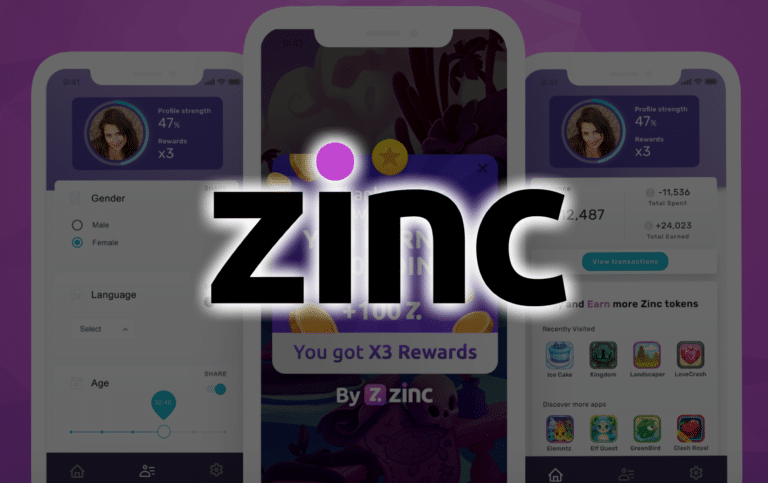Author: Alex Moskov / Source: CoinCentral

Over 30% of the $335 billion projected ad spend in 2020 is estimated to be lost to inefficiencies in the current digital advertising landscape.
With nearly a third of all money that goes into digital advertising getting thrown into the abyss of click farms, click spam, malware, ad stacking, bots, and other wasteful activity, it’s no surprise dozens of entrepreneurs in the space are turning to build businesses around solutions.
Zinc is a blockchain-based advertising protocol looking to crack the code to salvage some of the estimated $100.5 billion that goes to waste.
Zinc incentivizes users to be more engaged with the platform by compensating them with rewards for the ads they watch in the apps they already use. These rewards can be spent to reduce the number of ads they see, as well as accessing premium features and content inside Zinc Protocol partner apps.
Daniel Trachtemberg, the CEO and Founder of Zinc, was previously the Head of Mobile Fraud Prevention and Director of the Mobile Data Management Platform at app monetization company ironSource with over 1.5 billion monthly active users.
How does Zinc differentiate from other similar projects targeting blockchain in advertising, such as Basic Attention Token?
One of the main challenges for all new startups, especially in decentralized ecosystems like blockchain based dApps is distribution: user acquisition & adoption.
BAT is aiming to drive adoption through their web browser – the “Brave” browser. A great product, but getting the users to adopt a new browser and change their habits on that level is quite a challenge. So one key difference is that users who will participate in the Zinc protocol ecosystem will gain more rewards within the apps they already use. Basically, apart from having to install the Zinc wallet app, where users choose what information to share with advertisers, they continue doing everything as they do now, and so does the rest of the industry. Another key difference between Zinc and other projects is that the Zinc Protocol does not aim to cut out the middleman. A lot of projects are claiming that the problem is the middlemen and if advertisers and publishers had a way to work together those problems would be solved, which in concept is a great idea, but in practice we think it’s a bit naive.
It seems that Zinc is focusing efforts into app-based advertising rather than website advertising. Is site-based advertising something Zinc will explore in the future or do you see the future of digital advertising as being app-based?
Web-based advertising is something Zinc will definitely explore in the future. However, it seems the general trend is towards mobile: more and more people spend more time on their mobile phones. Mobile is a segment that’s showing rapid growth and advertisers see the potential, which is evident when you look at the growth of marketing budget spend on mobile each year.
But this growth also fuels inefficiencies and fraud, keeping big brand advertisers away from running mobile campaigns, which, in my opinion, is quite a paradox: as fraud grows in relation to mobile spend growth. So if we eliminate fraud & data inefficiencies, mobile can become even a greater untapped channel – especially for brand advertisers with big budgets.
In addition to fraud, access to quality data is one of the issues faced by advertisers. Can you explain why this is an issue, and how Zinc will provide better data quality to advertisers?
First party, real human-verifiable user data is the most precious asset traded in the advertising ecosystem, I would dare to say even more than actual ad real estate.
Most advertising budgets are dedicated to targeting specific audiences. So if a publisher succeeds in attaching high quality, verifiable user data when selling an ad space, the amount of money he’ll be able to charge is exponentially higher than without this user data – this is key to understanding how Zinc will generate value for all the players in the ecosystem, including the user/consumer.
Today only Facebook and Google and some PMPs (private marketplaces) have this kind of data. Imagine that you could target users outside the duopoly with the same accuracy – it will improve the way app developers and publishers do business (focusing of ad quality and not quantity): increase the advertiser’s capability to generate reach, and significantly improve the user experience.
That’s exactly what the Zinc protocol is meant for: ensuring users are real humans, allowing users to self-disclose basic information in exchange or getting more rewards and fewer ads via the Zinc token ecosystem. This first party data information will be used to target the specific audiences with a higher accuracy and efficiency resulting in higher revenue, less waste and better user experience.
Many app-based games such as Angry Birds already offer users the ability to earn and spend in-game rewards. How will the user experience with Zinc differ from this?
Most of the game publishers rely on advertising to achieve two main goals: the first, monetize and build their businesses; the second, keep players engaged…

